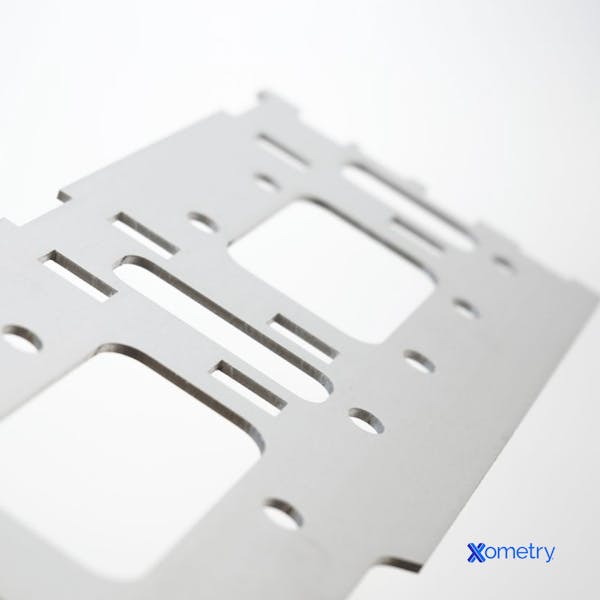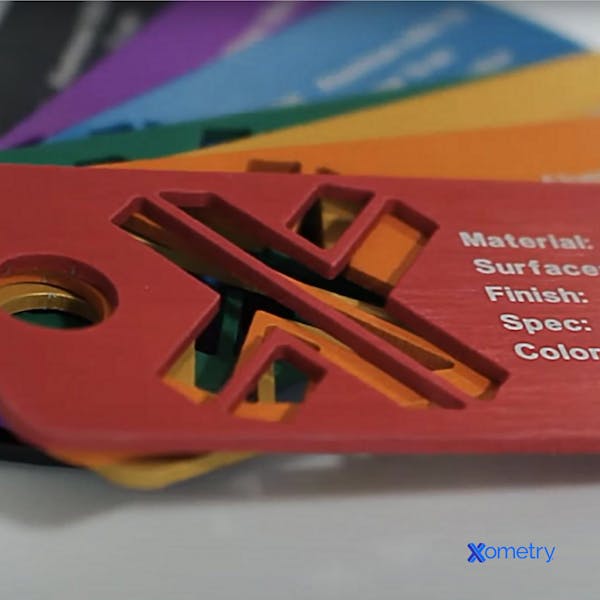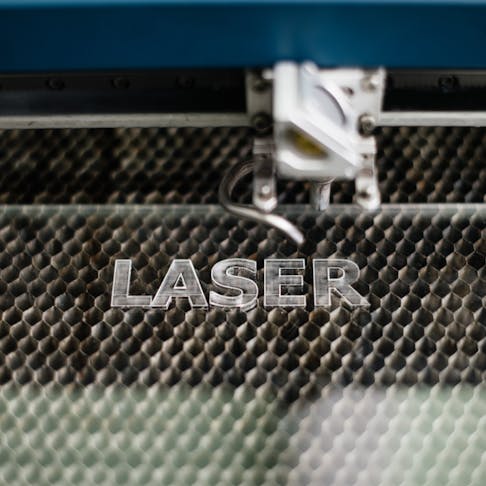Laser cutting and laser engraving are comparable processes that require very similar machines but have recognizable characteristics and outcomes. Both processes use high-intensity beams of light to either cut or engrave a material.
This article discusses what laser cutting and engraving are, their differences, and how to choose between them.
What Is Laser Cutting?
Laser cutting is a process that uses a high-powered beam of light to cut a target material into two or more parts. It supplements or replaces more conventional methods that use mechanical saws or shearing blades. The laser will vaporize/melt the material to create the cuts. Laser cutting is used in industrial manufacturing processes.
For more information, see our guide on How Laser Cutters Work.
How Does Laser Cutting Work?
Laser cutting works by focusing a high-powered laser beam on a small area in order to melt and vaporize part of the material. The vaporized material is then blown away from the cutting site by an inert gas, such as nitrogen. The laser is connected to and controlled by a CNC (Computer Numerical Control) machine which moves the laser along the part to create a cut. The CNC machine follows a path or series of paths written in G-code, which is created in computer-aided design (CAD) software and loaded onto the laser cutter.
What Is the Primary Purpose of Laser Cutting?
As the name implies, the primary purpose of laser cutting is to cut away portions of a part or material with more accuracy and precision than most other techniques. It is usually performed on metal or plastic items. Designers choose laser cutting for its precision and versatility, as well as its ability to create high-quality finished edges.

What Are the Advantages of Laser Cutting?
People choose laser cutting over conventional cutting methods because it:
- Can cut non-ferrous metals with ease.
- Is faster and more reliable than most methods.
- Can cut complex geometry with precision.
- Creates a high-quality edge that does not require post-processing such as deburring.
- Adapts to cutting different geometry.
What Are the Disadvantages of Laser Cutting?
There are disadvantages to using a laser cutter such as those listed below:
- High upfront cost.
- High energy demand.
- Effective only on limited metal thicknesses.
- Some plastics generate dangerous fumes.
What Is Laser Engraving?
Laser engraving is a process that uses a high-powered laser to melt and vaporize enough material to leave a deep marking. Laser engraving does not, however, penetrate all the way through the material.
To read more, check out our guide on How to Do Laser Engraving.
How Does Laser Engraving Work?
Laser engraving works by focusing a high-powered laser on a small area of the material being engraved to melt and vaporize the surface layer. The laser is connected to and controlled by a CNC machine which follows a path set up by preprogrammed G-code software. The pattern in the G-code is created in a CAD model prior to engraving.
What Is the Primary Purpose of Laser Engraving?
The purpose of laser engraving is to create permanent markings. Paint and ink may fade or weather away, but laser-engraved markings are more resilient.

What Are the Advantages of Laser Engraving?
The advantages of using a laser engraving technique over other methods include:
- High precision
- High durability
- Speed of marking
- Highly accurate repeatability
- Adaptability to complex geometry
What Are the Disadvantages of Laser Engraving?
The disadvantages of laser engraving are:
- High equipment/setup cost
- No options for different colors
- Production of toxic fumes
- Requires training
- Limited to certain materials
- Produces stress concentration points which may lead to cracking
How To Choose Between Laser Cutting and Laser Engraving?
You’ll make your choice between a laser cutting machine and a laser engraving machine based on what you intend to do with it. If the machine is to be used solely for engraving, then a laser engraving machine will be best. However, if you want to do both laser cutting and engraving, then a laser-cutting machine will be the better option. More importantly, the machine you choose will also depend on the type of material you plan to cut or engrave; different materials require different power levels.
Common FAQs About Laser Cutting and Engraving
How Do Laser Cutting and Engraving Differ in the Type of Laser Used?
Laser cutting and engraving machines often employ the same types of lasers. Indeed, a device intended to engrave metal will be powerful enough to cut plastic. Furthermore, there are many machines that can both engrave and cut plastics or metals. Laser-cutting machines can feature CO2, fiber, or neodymium lasers.
How Do Laser Cutting and Engraving Differ in Speed?
Laser engraving and laser cutting are performed at different speeds. Laser engraving is always faster than laser cutting for the same material. If the beam remained in place too long, it would slice through the material rather than merely engrave the surface. Such is the point during laser cutting operations, though, so in the case of cutting, the beam will dwell long enough to slice all the way through. Both laser cutting and engraving operations can be done faster when using a high-powered laser. However, there is a limit, and cutting or engraving too quickly will reduce the edge quality.
How Do Laser Cutting and Engraving Differ in Terms of Power?
There are high-powered machines that can perform both laser cutting and laser engraving. However, as a general rule of thumb, machines that put out less than 60W are considered laser engravers. Above that power output, they are considered laser cutters. Of course, the specific power threshold can vary depending on the specific laser type (CO2, fiber, etc.) and the materials being processed.
What Differs Between Laser Cutting and Engraving in the Application?
The difference between the application of laser cutting and engraving is that laser cutting is intended to penetrate the whole thickness of the material and split it into multiple pieces. Laser engraving, on the other hand, penetrates only the surface layer. The main difference in the machine used for these applications is the lens focal length. While some machines can both cut and engrave, engraving machines generally have a shorter focal length in order to produce a smaller contact area. By comparison, laser cutters have a longer focal length that reduces the tapered slope created on the material’s cut edge, which is apparent when cutting thick materials.
Can a Laser Engraver Machine Be Used as a Laser Cutter?
No, generally speaking, a machine that is considered to be a laser engraver (under 60W), cannot cut most materials. If you need a machine that can both engrave and cut, then a high-power laser cutter can do the trick. Technically, though, such a machine is considered a laser-cutting machine.
Is Laser Cutting More Expensive Than Laser Engraving?
Yes, generally, laser cutting is more expensive than laser engraving because the machine costs more and takes more power when cutting. Additionally, laser cutting takes more time per inch, so it runs for longer.
Do Laser Cutting and Engraving Use the Same Materials?
Yes, laser cutting and engraving machines often work the same way so they are built from the same materials. Laser engraving or cutting heads contain either a CO2, fiber, or neodymium laser.
How Do Laser Cutting and Engraving Software Packages Differ?
Laser cutting operations work from vector files, while engravers can operate using vector or raster file types. Raster files functionally contain a series of colored pixels that form the path and can be read by the laser engraver. Vector files use lines, curves, and equations originating from fixed points to produce a continuous path that can be read by a laser cutter or engraver.
Summary
This article presented laser cutting vs. laser engraving, explained each of them, and discussed their key differences. To learn more about laser cutting and laser engraving, contact a Xometry representative.
Xometry provides a wide range of manufacturing capabilities, including sheet cutting and other value-added services for all of your prototyping and production needs. Visit our website to learn more or to request a free, no-obligation quote.
Disclaimer
The content appearing on this webpage is for informational purposes only. Xometry makes no representation or warranty of any kind, be it expressed or implied, as to the accuracy, completeness, or validity of the information. Any performance parameters, geometric tolerances, specific design features, quality and types of materials, or processes should not be inferred to represent what will be delivered by third-party suppliers or manufacturers through Xometry’s network. Buyers seeking quotes for parts are responsible for defining the specific requirements for those parts. Please refer to our terms and conditions for more information.


